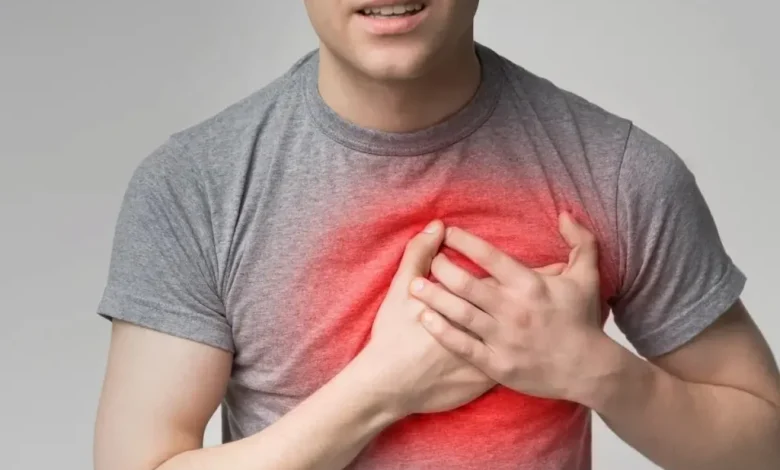Your Body’s SOS: The Top Signs of a Heart Attack You Should Never Ignore

When it comes to heart attacks, every second counts. Your body often gives warning signals long before catastrophe strikes — yet many people brush them off as fatigue, indigestion, or stress. Recognizing the early signs of a heart attack could be the difference between life and death.
The top warning signs of a heart attack, how they manifest differently in men and women, what causes them, and what immediate actions to take. Let’s decode your body’s SOS before it’s too late.
Understanding a Heart Attack: What’s Really Happening Inside Your Body
A heart attack, medically known as a myocardial infarction, occurs when blood flow to part of the heart muscle is blocked. This blockage is typically caused by a buildup of plaque — a mix of cholesterol, fat, and other substances — inside the coronary arteries. When the plaque ruptures, a blood clot forms, cutting off oxygen and nutrients. Without oxygen, heart cells begin to die within minutes.
While the process sounds sudden, heart attacks are often years in the making. Silent damage to the arteries develops gradually, and your body may send distress signals before a full-blown cardiac event occurs.
Why Recognizing the Signs Early Matters
According to the World Health Organization (WHO), cardiovascular diseases are the leading cause of death globally — claiming around 18 million lives every year. Yet, up to 80% of heart attacks are preventable with lifestyle changes, early detection, and rapid treatment.
If you catch the warning signs early enough and seek medical help immediately, doctors can often restore blood flow and prevent severe heart muscle damage. But ignoring symptoms — even for a few hours — can lead to irreversible consequences.
Top Warning Signs of a Heart Attack
1. Chest Discomfort: The Most Classic Warning Sign
The most recognized symptom of a heart attack is chest pain or pressure. However, it doesn’t always feel like a sharp stab — many describe it as:
- A tightness or squeezing feeling in the center of the chest
- A sensation of pressure or fullness, as if something heavy is sitting on your chest
- Pain that comes and goes, lasting more than a few minutes
This discomfort often occurs during activity or stress but can also strike while resting. Some people, especially those with diabetes, may experience little or no chest pain — a condition known as a silent heart attack.
Never assume it’s “just indigestion” or “gas.” If the pain is persistent or worsening, seek emergency medical attention immediately.
2. Pain Radiating to the Arm, Neck, or Jaw
Heart attack pain isn’t always confined to the chest. The heart’s nerve pathways overlap with other areas, leading to referred pain. You might feel:
- A dull ache or pain spreading down your left arm (sometimes both arms)
- Neck, jaw, shoulder, or back pain
- Discomfort that starts in one area and moves elsewhere
Women, in particular, often experience jaw or back pain instead of the classic “crushing” chest sensation. This makes it easy to dismiss as muscle tension or arthritis, but it can be a red flag of restricted blood flow to the heart.
3. Shortness of Breath: When Breathing Becomes a Struggle
Feeling short of breath can occur with or without chest pain. During a heart attack, the heart struggles to pump effectively, causing fluid to back up into the lungs. You may feel:
- A sense of breathlessness during activity or at rest
- Difficulty catching your breath while lying flat
- A feeling like you can’t take a deep breath
If breathing becomes labored suddenly, especially alongside other symptoms, treat it as a medical emergency. This sign is particularly prominent in women and older adults.
4. Cold Sweats and Dizziness
A sudden, unexplained cold sweat — especially if accompanied by nausea or lightheadedness — is another hallmark of a heart attack. This happens because your body goes into “fight or flight” mode, releasing stress hormones like adrenaline in response to pain and oxygen deprivation.
You might feel:
- Clammy or pale skin
- A sensation of dizziness or fainting
- Weakness or an overwhelming sense of anxiety
These symptoms can mimic those of low blood sugar or dehydration, but when combined with chest discomfort or shortness of breath, they warrant immediate attention.
5. Nausea, Indigestion, or Stomach Pain
Many heart attack victims mistake their symptoms for indigestion or acid reflux. You might experience:
- Upper abdominal pain that feels like pressure or fullness
- Heartburn-like sensations that don’t improve with antacids
- Vomiting or a churning stomach
This is particularly common among women, whose heart attack symptoms often manifest in the stomach area rather than the chest. If you feel unwell after eating but also experience fatigue or chest discomfort, don’t assume it’s food-related — it might be cardiac distress.
6. Extreme Fatigue or Weakness
Have you ever felt unusually tired for no clear reason? Unexplained fatigue, especially in the days or weeks leading up to a heart attack, can be a significant warning sign.
You might notice:
- Feeling exhausted after routine activities like climbing stairs
- Struggling to stay awake or feeling drained for days
- A sudden drop in energy even after resting
Women are particularly prone to this symptom. In fact, studies show that 70% of women who experienced heart attacks reported extreme fatigue in the weeks prior.
7. Irregular or Rapid Heartbeat
If your heart suddenly starts racing, pounding, or skipping beats, it could be your heart signaling distress. Known as arrhythmia, this irregular rhythm can indicate that the heart’s electrical system is affected.
While occasional palpitations due to anxiety or caffeine are common, a sustained irregular heartbeat, especially when combined with dizziness or shortness of breath, could mean your heart is struggling to maintain normal rhythm during a cardiac event.
8. Swelling in the Legs, Ankles, or Feet
A lesser-known but serious sign is swelling (edema) in the lower body. When your heart isn’t pumping effectively, blood backs up in the veins, causing fluid retention.
You might notice:
- Puffy ankles or legs at the end of the day
- Weight gain due to fluid buildup
- Indentations when pressing on the swollen area
While swelling can also stem from kidney or liver issues, when combined with shortness of breath or fatigue, it can point toward heart failure or heart attack risk.
9. Persistent Cough or Wheezing
A chronic cough that produces pink, frothy mucus can indicate fluid buildup in the lungs due to poor heart function. This symptom often appears in people with congestive heart failure, but it can also precede a heart attack.
If you find yourself coughing frequently, especially when lying down, or hear a whistling sound (wheezing) when you breathe, get checked promptly.
10. Sense of Impending Doom
Many people who survive heart attacks report feeling a strong sense of dread or anxiety moments before the event. This psychological symptom, sometimes called “cardiac anxiety”, occurs because the brain senses a life-threatening imbalance in oxygen levels.
If you suddenly feel uneasy or panicked for no clear reason — particularly with chest pressure or shortness of breath — it’s your body’s way of urging you to seek help immediately.
Heart Attack Symptoms in Women vs. Men
Men and women experience heart attacks differently, and this difference often leads to misdiagnosis in women.
| Symptom | More Common in Men | More Common in Women |
| Chest pain or pressure | ✔️ | ✔️ (but less intense) |
| Left arm pain | ✔️ | Sometimes |
| Shortness of breath | ✔️ | ✔️ |
| Nausea, vomiting, indigestion | Sometimes | ✔️ |
| Fatigue or dizziness | Sometimes | ✔️ |
| Jaw, back, or shoulder pain | Less common | ✔️ |
| Anxiety or sense of doom | Sometimes | ✔️ |
Because women’s symptoms are often subtler, they may delay seeking treatment — sometimes with fatal results. Awareness can save lives.
What to Do If You Suspect a Heart Attack
- Call Emergency Services Immediately (e.g., 911 or your local number).
Do not attempt to drive yourself to the hospital. Paramedics can begin life-saving treatment en route. - Chew (don’t swallow whole) one adult aspirin (325 mg) if not allergic or advised otherwise by your doctor. Aspirin helps thin the blood and improve flow to the heart.
- Stay calm and rest.
Sit down, keep your body relaxed, and avoid unnecessary movement. Anxiety increases your heart’s oxygen demand. - Unlock doors and inform someone nearby.
If you’re alone, call a friend or family member to alert them before emergency responders arrive. - Follow medical instructions carefully.
Once at the hospital, doctors may perform tests like ECG, blood work (for troponin levels), or angiography to assess heart damage and restore circulation.
Who’s Most at Risk for a Heart Attack?
Certain factors significantly increase your risk. Understanding them helps you take preventive action:
Uncontrollable Risk Factors
- Age: Risk increases after 45 for men and 55 for women.
- Family History: Genetics play a major role in heart disease.
- Gender: Men are more likely to have early heart attacks, though women’s risk rises post-menopause.
Controllable Risk Factors
- High blood pressure (hypertension)
- High cholesterol (LDL)
- Smoking
- Obesity and poor diet
- Diabetes
- Chronic stress and lack of sleep
- Sedentary lifestyle
The good news? Modifying even a few of these can drastically reduce your risk.
How to Prevent a Heart Attack: Proactive Steps for a Healthy Heart
1. Adopt a Heart-Healthy Diet
Focus on foods rich in omega-3 fatty acids, fiber, and antioxidants:
- Fresh fruits and vegetables
- Whole grains and legumes
- Fatty fish like salmon
- Nuts and olive oil
Avoid trans fats, excessive salt, and processed sugars.
2. Exercise Regularly
Aim for at least 150 minutes of moderate activity (like brisk walking or swimming) per week. Exercise helps maintain healthy weight, improves circulation, and strengthens the heart muscle.
3. Manage Stress
Chronic stress raises blood pressure and triggers inflammation. Try mindfulness, yoga, or deep-breathing exercises to promote relaxation.
4. Control Blood Pressure and Cholesterol
Regularly monitor both levels and follow your doctor’s treatment plan if they’re elevated. Lifestyle changes combined with medication can prevent arterial damage.
5. Quit Smoking and Limit Alcohol
Smoking damages arteries and lowers oxygen supply. If you smoke, seek help to quit. Alcohol should be consumed in moderation — ideally no more than one drink per day for women and two for men.
6. Get Regular Checkups
Routine screenings for blood pressure, cholesterol, and blood sugar can catch problems early before they escalate into heart disease.
When in Doubt, Get Checked Out
It’s always better to overreact than to underreact when it comes to heart health. Ignoring symptoms out of embarrassment, fear, or uncertainty can have devastating consequences. Even if it turns out to be a false alarm, a quick checkup can reassure you or save your life.
Remember:
“Time is muscle.”
The faster you act, the more of your heart muscle can be saved.
Final Thoughts: Listen to Your Body’s SOS
Your body rarely stays silent when something is wrong — especially when it comes to your heart. Subtle signs like fatigue, breathlessness, or mild discomfort may seem harmless, but they can be your heart’s desperate cry for help.
By learning to recognize these signals, adopting a heart-healthy lifestyle, and responding promptly to warning symptoms, you can dramatically reduce your risk of heart attack and ensure a longer, healthier life.




